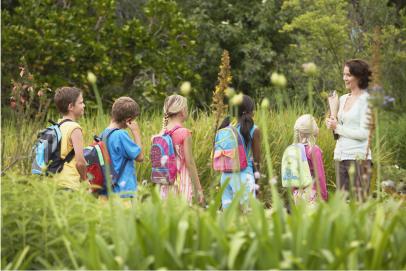 By: By: Dan Wyrick K-8 Elementary Program Consultant and Director of Nature by Design Acampo, CA
By: By: Dan Wyrick K-8 Elementary Program Consultant and Director of Nature by Design Acampo, CA
Did you know that every third bite of food we eat is a result of pollinators?
It’s true! Bees, butterflies, birds, and other pollinators help grow our food, keep our flowers blooming, and make our lands healthy. For many reasons, including lack of habitat, pollinators are struggling to survive.
In 2014, President Obama directed all federal agencies to assist in pollinator conservation to protect our nation’s food security and to help keep pollinators healthy. Obama’s National Pollinator Initiative is a commitment to sustaining the future of pollinators through research, policy, education, and action. As pollinators thrive and multiply, our nation will benefit.
Butterfly and bird gardens help with this effort and can increase student engagement and curiosity in the summer classroom. By planting a butterfly and bird garden, you create an interactive classroom for your students to be engaged in the natural world. This outdoor summer classroom can be a tool to incorporate hands-on activities for every subject! Many students do not spend their time outdoors; providing a garden that can be used by your students gives them an opportunity to be outside and interact with nature. Through activities involving the summer garden, students will develop a connection with the outdoors from an early age. This enriching experience will be something that they will keep with them for the rest of their lives.
It is important to educate your students and community about the importance of planting native gardens so that you can help create more gardens around your community. The more gardens there are that are free of pesticides and herbicides and full of native plants, the healthier your area’s ecosystem will be!
Attracting birds and butterflies to your summer garden area is not difficult to do if you provide a long-term source of food, fresh water, and a place of safety. This involves planting the kinds of flowers, shrubs, vines, and trees that provide berries, seeds, and nectar; a nesting area that is protected from predators; and fresh water for drinking and bathing. And, yes, you can do all that in a small space with container gardens. Even if your summer garden is located in a city, birds and butterflies will accept your garden plot, fence-line plot, or containers as a welcome oasis and pay regular visits. There are many online resources that provide directions for designing such gardens.
Grow sun-loving native flowers (particularly those that grow wild in meadows) in your garden plot or containers to attract songbirds, hummingbirds, and butterflies. Choose brightly colored flowers. Plant both annuals and perennials. Pick native species to your area. Let students research the kinds of local plants that are most likely to attract birds and butterflies. Recommended plants include aster, purple cone flower, sunflower, lupine, daisy, goldenrod, salvia, sage, butterfly bush (Buddleia), hollyhock, milkweed, honeysuckle, lantana, and star jasmine. Butterfly- and bird-friendly trees include birch, crabapple, poplar, cherry, willow, and oak. Additional lists of plants, including local native plants, are available online.
Supplement the food provided by your gardens with a bird feeder and a supply of commercial seed mix to attract a variety of birds. A hummingbird feeder with sweetened water (avoid using colored water), a feeder with thistle seeds, a feeder with black sunflower seeds, and strategically placed suet blocks are all effective in attracting birds. Birds quickly become dependent on feeders, so remember keep the feeders filled.
In any butterfly and bird garden a source of fresh water is essential. You can buy a birdbath or a fountain, or let your students construct their own water source. Remember that the water source needs to be shallow; the water should be no more than two or three inches deep. Vegetation planted around running or dripping water is great for attracting birds and butterflies (butterflies like to take a drink, too). Make sure the bath is placed high enough to be secure, which means too high for a cat to reach it. See that there is a perch, or a level rim, or rocks placed in the container so that your birds can walk into the water to safely bathe or sit and dip their beaks into it.